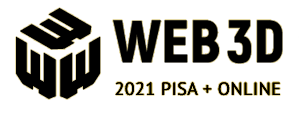Conference Tracks
The conference is focused on the ecosystem of 3D on the web platform, addressing its research, development, and applicative use. The theme for this year will be “A Shared 3D Workspace”. Working together online has been the staple of this last year. Web3D technologies can create a shared, online workspace, with multiple users able to connect and work together in the same environment.
MAIN TRACK. The conference seeks to cover the world of 3D on the Web across multiple levels: from low-end layers enabling the use of 3D in the browsers, to high-level applications. The Main Track of the conference is the more technical- and research-oriented part of the conference, focusing on more original, innovative content.
SESSION: WEB3D FOR COVID RESPONSE. The sudden switch to remote teaching/working/interacting prompted many urgent requests for new tools, systems, and paradigms. And the research community answered. In this track, we intend to bring to the fore all the work done to virtually shorten the distance across people during this emergency, presenting results, innovative approaches, interaction paradigms, and subsequent evaluations.
SPECIAL TRACK: DIGITAL FASHION IN THE WEB. The future of fashion is presented from one of the historic centers of fashion. We invite experts in various fields of fashion that have effectively used Web3D technologies in their research and academic and public educational activities.
For the Fashion Industry, the Web is a great way to reach the global public; Web3D makes this reaching out interactive. A growing applicative field exploiting these opportunities is certainly the Fashion Industry, which in these last years has been going through impressive virtualization of its production chain.
This special track is dedicated to the results and new challenges to bring the Fashion Industry in the 3D Web: import of assets, collaborative tools, virtual fashion shows, and clothes simulation are just a few examples.
SPECIAL TRACK: ONLINE LEGACIES AND CULTURAL HERITAGE. The Cultural Heritage domain is increasingly using Web3D technologies to share data for teaching, research, and dissemination among peers and the general public. In this special track, we seek to explore more specifically how 3D web technologies contribute to knowledge production once the data have been processed, shared, and used through online platforms. What is the legacy and impact of virtual content in documenting, interpreting, and showcasing Cultural Heritage?
To answer this question, we invite experts in various fields of Cultural Heritage that have effectively used Web3D technologies in their research and academic and public educational activities. Particular emphasis will be placed on projects focusing on mobile objects, spanning from archaeological finds to reference collections, to closed and open online repositories, and from pipelines to process 3D models for the Web to visualization and design methods. We are particularly interested in experiences stemming from (but not limited to) scholarly research, teaching, curatorial and museum practices, scientific dissemination, and more generally public engagement.
Topic Areas
Topics of interest for the Web3D conference include but are not limited to:
- HTML5 3D, WebGL, X3D
- 3D data formats, compression, transmission, and streaming
- Web-based rendering, advanced shading
- VR/AR
- 3D content creation, authoring, modeling
- Web-based Geometry Processing
- 3D printing
- 3D API, middleware, toolkits, frameworks
- AI for Web3D
- Human modeling on Web3D
- Semantic Web
- Cloud-based services for large-scale datasets
- Shared virtual spaces, collaborative environments
- Virtual humans, avatars, motion capture
- 3D repositories, marketplaces, asset galleries
- Mobile platforms
- 3D web-based teaching facilities
- Multi-modal 3D interaction paradigms, 3D navigation, gesture, natural interfaces
- Visual analytics
- Diffusion and adoption of 3D Web technologies, comparative studies, historical perspectives, WWW integration
- Novel interactive 3D web applications in all areas and sectors such as entertainment, education, training, cultural heritage, digital twin, medicine, military, smart-manufacturing / industry 4.0, information and data visualization, science, geographic information systems (GIS), digital globes, subsurface exploration and mining, integrated marine data management and visualization, building information modeling (BIM), and architecture
Submission Guidelines
TECHNICAL PAPERS. We welcome original scientific works presenting 3D web research and applications. Full or Short format (9 or 5 pages, respectively); submissions will be peer-reviewed, Single Blind. Accepted papers will be published in the ACM Digital Library and submitted to major indexing services. Works selected for the Best Paper awards will be invited to submit extended versions to a selection of specialized Journals.
INTERACTIVE POSTERS. This year, we would like to push forward the concept of a poster: instead of an A1 sheet of paper, the content of the poster will have to be available online, in an interactive format. Posters are an ideal method to present more applicative works, tech demos, ongoing research, applications.
TUTORIALS. Tutorials are a way to present new tools to students, researchers, and professionals. Short courses, possibly with hands-on examples and interactive materials. Particularly encouraged are tutorials focused on open software/standards/data.
INDUSTRIAL USE CASES. Web3D is an ecosystem with a strong Industrial presence. The Industrial Use Cases is a way for companies and practitioners working with Web3D to present their solutions and technologies. The availability of an online, interactive version of the submission is encouraged.
WORKSHOPS/ROUNDTABLES. Web3D conferences have always been an opportunity to connect with other experts. Researchers, practitioners, standard committees, workgroups may propose to organize a workshop on specific themes of interest for the Web3D community. Workshops may be presentation sessions moderated by workshop organizers or open discussions on a specific topic of interest.
Submission Instructions
The instructions and the link to the online submission system can be found on this webpage.
Important Dates
The submission deadlines can be found on this webpage.
More Information
All questions about submissions should be emailed to program2021@web3d.org
